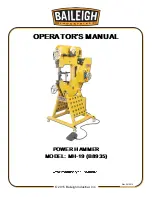
wire. The heat means wasted electricity and possibly
slightly lower voltage.
Use copper wire. Do not allow an electrician to use alu-
minum wire on your new circuit. Aluminum terminals
corrode worse than copper and require greater installa-
tion care. Avoid using extension cords.
Voltage Affects Firing Time
Voltage fluctuation can vary the firing time for a given
pyrometric cone from as little as one half to more than
twice the average time. If the voltage is too low, the kiln
will never reach full temperature. This can be corrected
only by having the utility company adjust the voltage.
PREPARING THE KILN
Kiln Features
Heating Elements
The heating elements in your Delphi kiln are heavy
duty for long life. All high temperature, heavy duty ele-
ments must be handled carefully. They are quite brittle
after being heated to a high temperature and will break if
bent while cold. By heating to a dull red glow with a pro-
pane torch, an element may be bent safely.
Never allow glaze, glass, silica sand, kiln wash, or other
foreign materials to touch the elements since they will de-
stroy the element when the kiln is fired.
Peephole
A peephole, tapered for a wide view without heat loss, is
used for observing the progress of your firing so you can
see when the pyrometric cones bend. Use at least one
large cone on the shelf during
every firing. With venting as
their secondary function,
peepholes allow oxygen to be
drawn into the kiln's chamber
and serve as an escape pas-
sage for smoke and water
vapor.
When looking through the
peepholes, always wear firing safety glasses, which are
available from Delphi. They protect your eyes from the
bright glare of the firing chamber and make it easier to
see the cones at high temperatures.
Prop-R-Vent
Ceramic pieces re-
lease gases and water
vapor during firing.
Venting allows these
gases
to
escape.
Delphi's fall away
Prop-R-Vent is in-
stalled on the switch
box. The prop supports
the lid in an open posi-
tion during the venting period. The Prop-R-Vent vents
the lid in two stages.
To close the lid after venting, lift the lid handle an inch.
The Prop-R-Vent will fall down by itself. Lower the lid
gently; warranty does not cover damage to the kiln or the
ware due to a dropped lid. For lusters and overglazes, en-
gage the Prop-R-Vent in its second position for additional
venting. Do not rush the cooling of your kiln with the
Prop-R-Vent. This can damage your ware.
The Lid Support
Your kiln has the lock-in lid support. Please do not let
unattended children raise the lid. Do not let the lid drop.
It is fragile and must be lowered gently.
Dust-Free Refractory Coating
The dark coating on the lid, the top rim of firebricks,
and in the peepholes reduces dust and hardens the fire-
brick surface for longer life. Though it will lighten after
the first firing, the coating will last for several years.
PYROMETRIC CONES
Pyrometric cones are small pyramids of clay and min-
eral oxide that soften and bend when exposed to heat.
They indicate when your ware has fired to maturity.
When consulting your dealer with a glaze problem, you
should have a bent cone from that firing. The cone will
help trouble shoot the problem. The cone lets you com-
pare one firing to the next.
Cone Numbers
Pyrometric cones are numbered from 022 through 01
and 1 through 10. Cone 022 matures at the lowest tem-
perature, and 10 matures at the highest. The number is
stamped on the base of the cone. The cone number for
each material is usually stated on the label by the clay or
glaze manufacturer.
Using Cones
Place the cones on a kiln shelf with the ware. As the
cones heat and bend, they form a glassy material that will
stick to a bare shelf. Therefore, apply kiln wash to the
shelves to prevent sticking. Do not apply kiln wash to the
cones. (See page _ for kiln wash.) The cone slants 8 de-
grees from vertical and bends in the direction of the slant.
They will not bend accurately if
they are slanted at the wrong an-
gle. Place the cone so that it will
not touch nearby ware as it bends.
Large cones come in either
standard or self-supporting.
Standard large cones must be
mounted in a clay or wire plaque
with 2" of the cone exposed above
the cone holder. Or you can
mount large cones in a pat of clay.
The pat of clay should be com-
4
Regular large cones re-
quire a cone plaque.

























